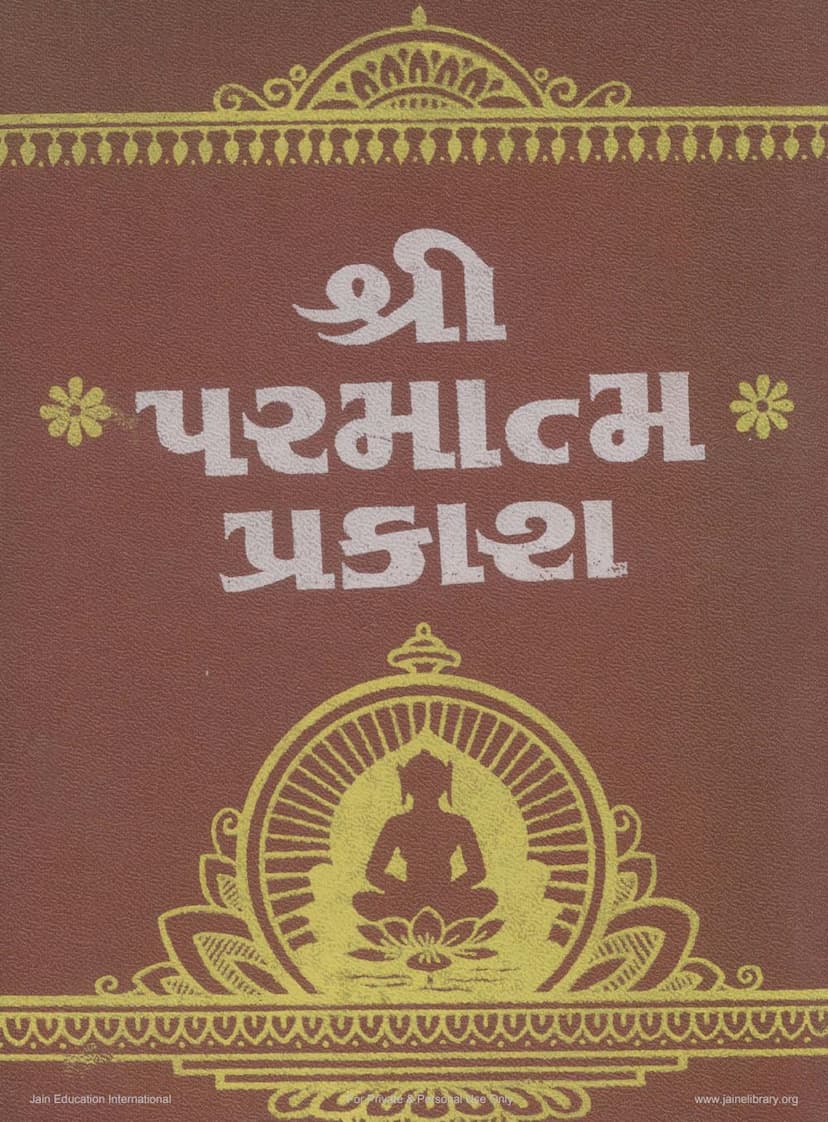Parmatma Prakash
Added to library: September 2, 2025

Summary
Here's a comprehensive summary of the Jain text "Parmatma Prakash" based on the provided pages:
Book Title: Parmatma Prakash Author: Amrutlal M Zatakiya (Translator) Publisher: Shri Vitrag Sat Sahitya Prasarak Trust, Bhavnagar Original Author: Shrimad Yogiindudev Commentary: Shri Brahmadev (Sanskrit Commentary)
Core Message and Content:
"Parmatma Prakash" is a profound Jain spiritual text that aims to guide individuals towards the realization of their true self, the soul (Atman), and ultimately, the state of the Parmatma (Supreme Soul). The text emphasizes the path of self-realization and spiritual liberation (Moksha) through the understanding and practice of Jain principles, particularly focusing on the internal spiritual journey.
Key Themes and Concepts:
-
The Nature of the Soul (Atman): The text delves into the essence of the soul, describing it as pure, eternal, conscious, and blissfully residing in its inherent nature, free from karmic bondage and impurities. It highlights the soul's distinctness from the physical body and all material possessions (Dravya, Karma, Karma-karmas).
-
The Path to Parmatma (Supreme Soul): The core of the text revolves around achieving the state of Parmatma. This is primarily achieved through:
- Bhed-Vignan (Discrimination): The ability to differentiate between the soul (Atma) and the non-soul (Jiva vs. Ajiva). This involves understanding the true nature of the soul as distinct from the body, senses, mind, emotions, and karmic impressions.
- Bhavna (Meditation/Contemplation): Continuous and unwavering contemplation on the true nature of the soul is presented as the most crucial practice. This includes focusing on the soul's inherent qualities of pure consciousness, infinite knowledge, perception, bliss, and power.
- Samyak Darshan, Gyan, Charitra (Right Faith, Right Knowledge, Right Conduct): These three jewels (Ratnatraya) are repeatedly emphasized as the foundation and the path to liberation. They are not merely external observances but internal realizations and practices.
- Nirvikalpa Samadhi (Undifferentiated Meditation): This is the state of profound meditation where the soul is absorbed in its own essence, free from any external or internal disturbances, mental fluctuations, or dualities (like pleasure/pain, birth/death).
-
The Three Types of Soul (Atma): The text categorizes the soul's state of awareness:
- Bahir-atma (External Soul): One who identifies with the physical body, senses, and external world. They are engrossed in worldly pleasures and sorrows.
- Antar-atma (Internal Soul): One who has begun to understand the difference between the soul and the non-soul. They strive for spiritual practices and contemplation but may still have subtle attachments.
- Parmatma (Supreme Soul): The soul that has achieved complete liberation, realized its true form, and is free from all karmic bondage. This is the ultimate goal.
-
The Impermanence of Worldly Affairs: The text repeatedly contrasts the transient nature of the external world, including the body, relationships, possessions, and sensory pleasures, with the eternal and unchanging nature of the soul. It warns against attachment to these impermanent things, as they lead to suffering.
-
The Role of Knowledge and Scripture: While emphasizing direct experience and realization, the text also acknowledges the importance of scripture and wise teachers (Gurus) as guides. However, the ultimate realization comes from within, through self-effort and internal contemplation.
-
The Goal of Moksha (Liberation): The ultimate aim is Moksha – the complete cessation of the cycle of birth and death, the shedding of all karma, and the attainment of eternal bliss and omniscience, residing in the soul's pure and inherent nature.
-
Critique of External Rituals without Internal Realization: The text implicitly (and sometimes explicitly) cautions against performing rituals, penances, or adhering to external forms of religion without the internal understanding and transformation of the soul. True devotion and liberation stem from the realization of the soul's true nature.
Structure and Presentation:
The provided pages indicate that "Parmatma Prakash" is presented with a Sanskrit commentary by Shri Brahmadev and a Gujarati translation and commentary by P. Amrutlal M. Zatakiya. The text is structured into sections and chapters (Mahadhikar), often using dohas (couplets) as the primary poetic and teaching format. The catalog link suggests a larger collection of Jain scriptures, implying this work is part of a broader devotional and philosophical corpus. The publisher's note highlights the popularity of the first edition and efforts to make the book accessible through subsidized pricing.
In essence, "Parmatma Prakash" is a guide to inner transformation, teaching that liberation is not achieved through external actions alone but through the profound realization of the soul's inherent purity and divinity, leading to a state of eternal bliss and freedom.